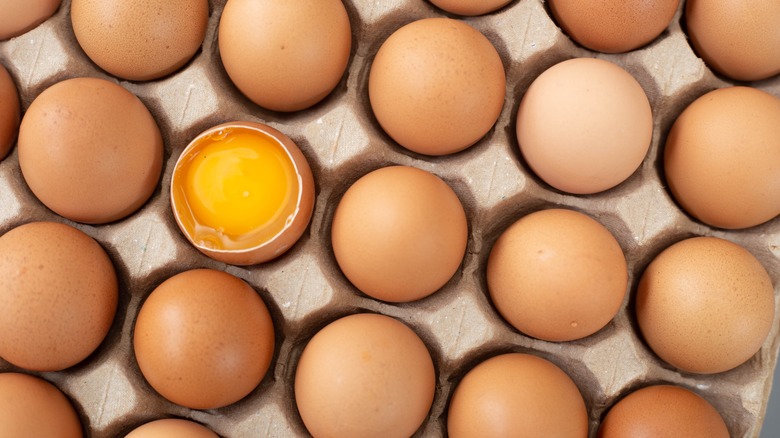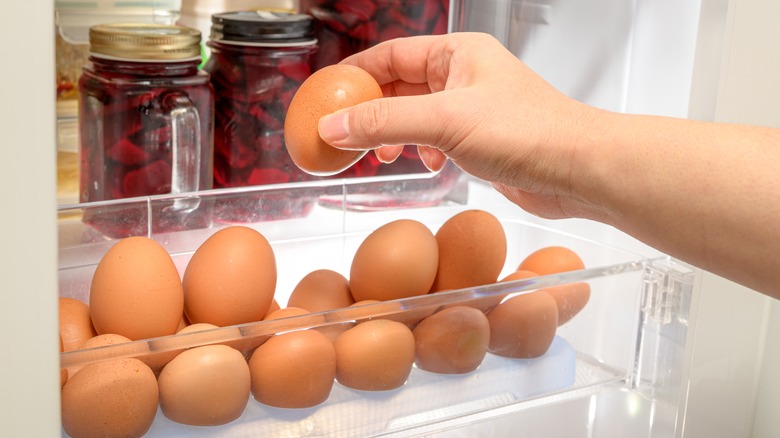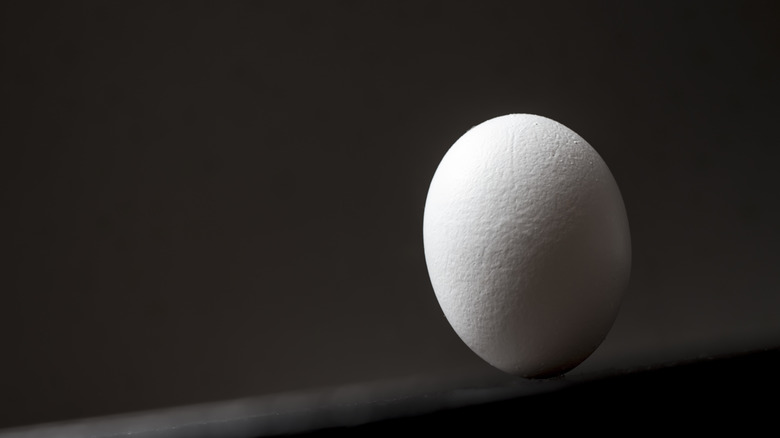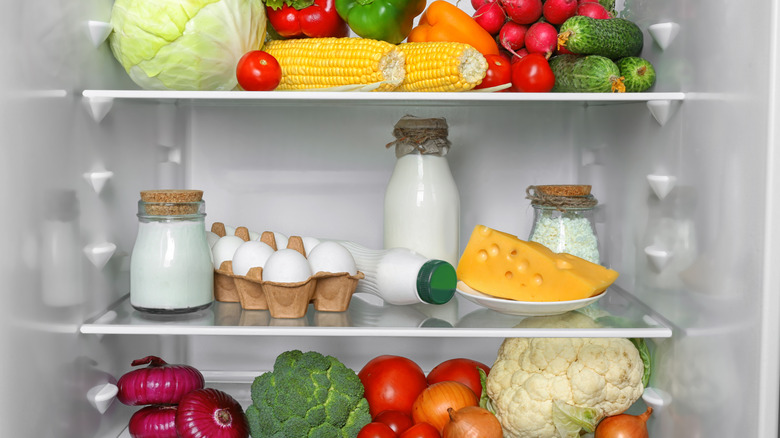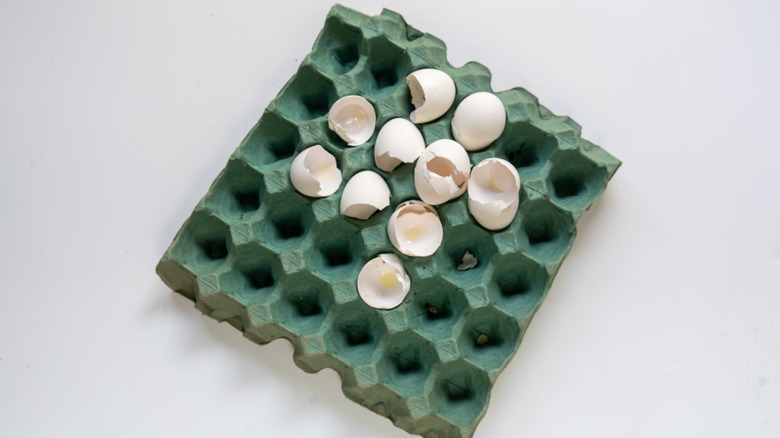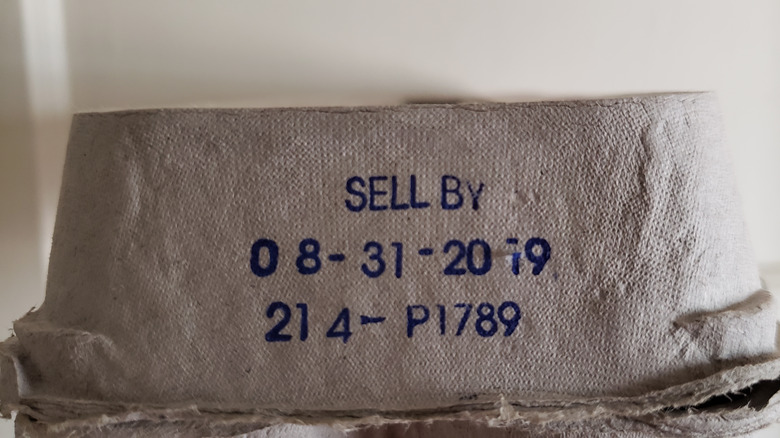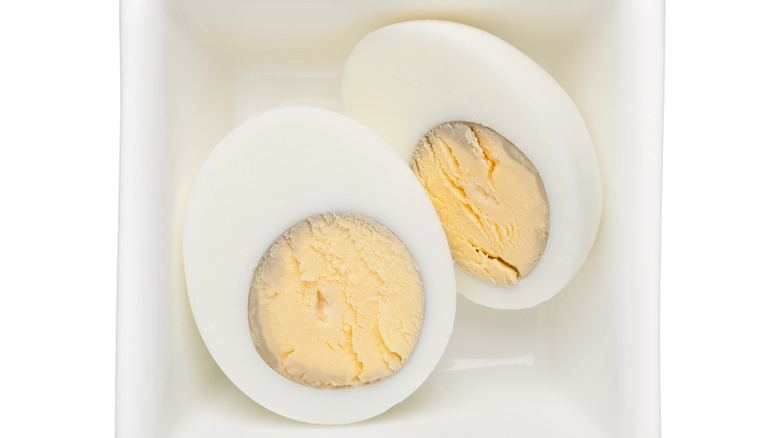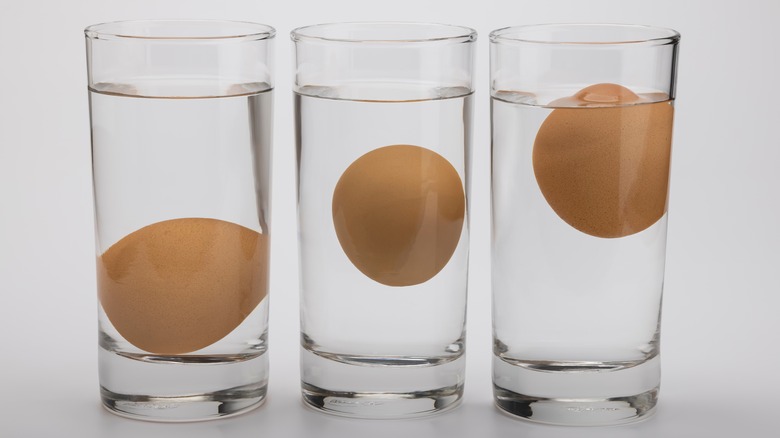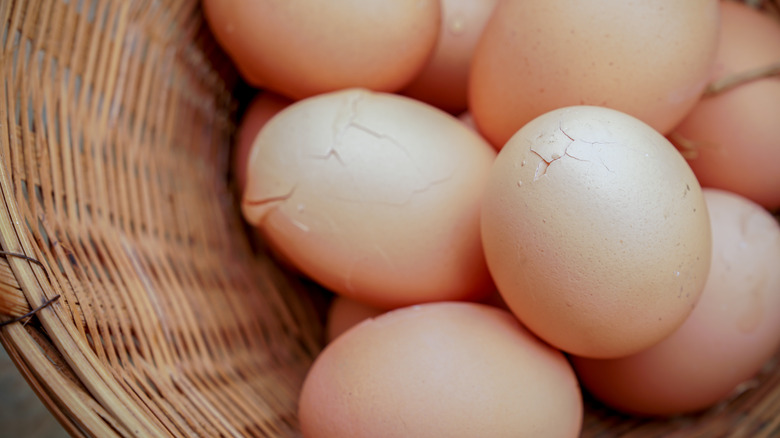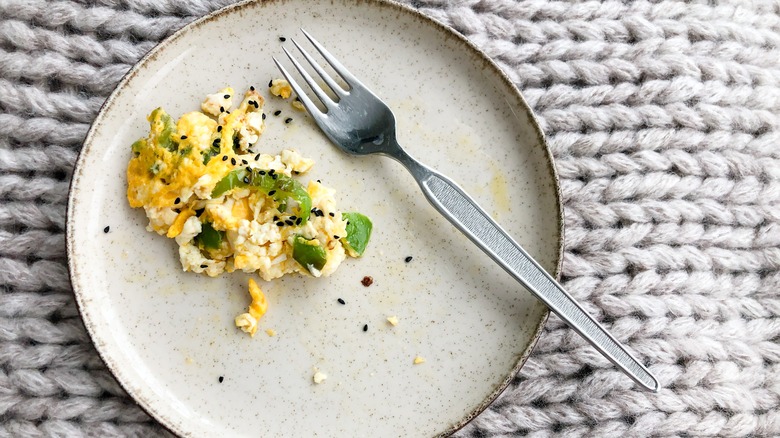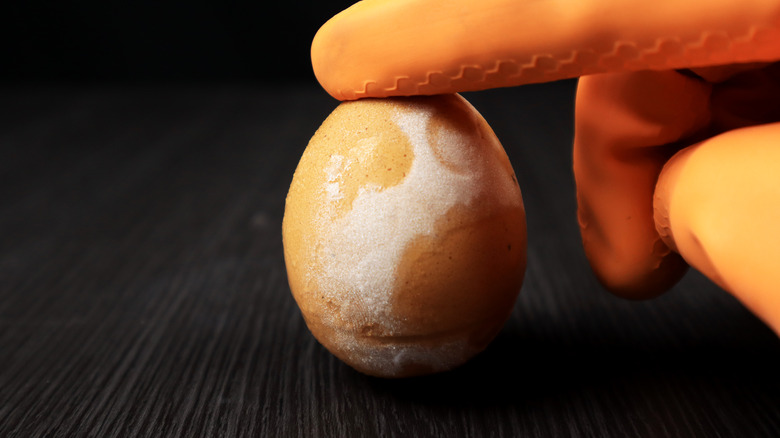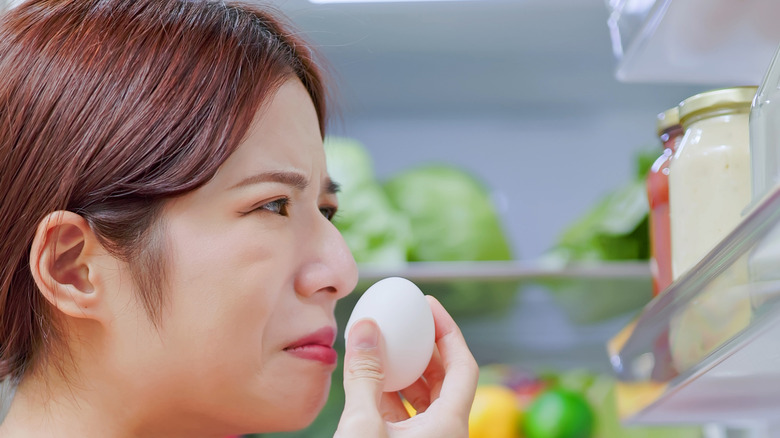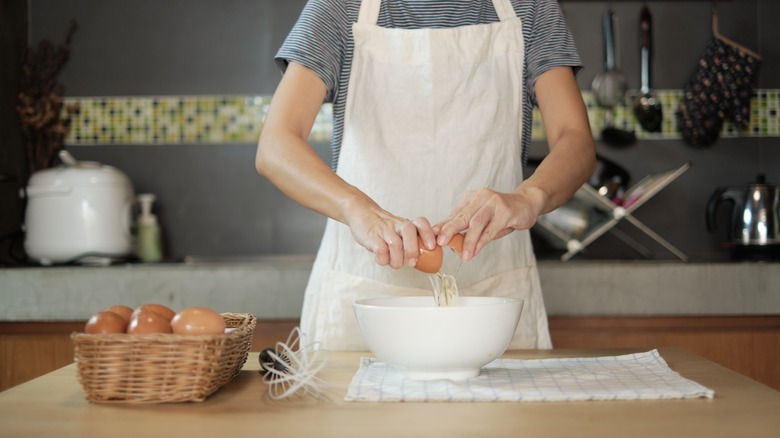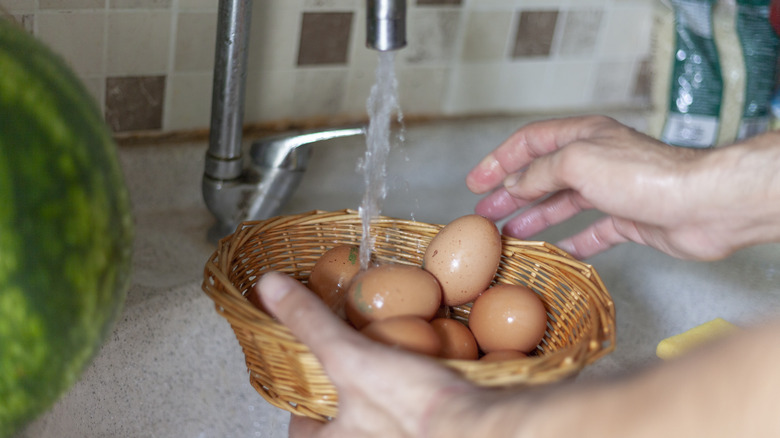14 Egg Safety Tips Everyone Needs To Know
Eggs are considered a superfood worldwide, as humans noticed how nutritious they were long ago. According to Healthline, one boiled egg contains impressive amounts of selenium and vitamins B2 and B12 and provides the human body with a small amount of almost every nutrient it needs. Although high in cholesterol, eggs don't necessarily negatively affect blood cholesterol. It all depends on the individual organisms.
As eggs are consumed in so many ways, an entire industry has developed around them. We don't only eat chicken eggs but also ostrich, goose, duck, or guinea fowl eggs. Some of these may be harder to find, but they come with additional health benefits and are interesting due to the sheer size variety. When it comes to actually eating them, the most popular way of eating chicken eggs is to scramble them, with 40% of people preferring them this way. With eggs being such a popular food, it's good to keep in mind a few egg safety tips for the next time you buy, cook, store, or serve them.
Learn when to refrigerate eggs
If you've ever wondered why you find the egg section in the refrigeration area of any supermarket, you'll probably be surprised to find out that this is not the case in all countries. In the United States, it's recommended to store eggs below 40 degrees F, but countries overseas, such as the U.K. or Sweden, have different rules. The reason for this difference is the salmonella bacteria. In the U.S., the potential bacterial contamination is controlled by washing and refrigerating the eggs. On the other hand, some European countries have implemented egg-laying hen vaccination against salmonella.
So, if you're living in the U.S. and buying your eggs at the supermarket, you should refrigerate them. That is because disinfecting the eggs damages the protective cuticle that covers the shell so the bacteria can get inside the egg. If, however, you buy your eggs at a farmer's market, from a small producer, or raise your own hens, chances are the shells are not disinfected. In that case, you can keep the eggs on the counter or in cool places. Even still, storing eggs in the refrigerator means they maintain their freshness twice longer as those held outside the fridge.
Store eggs correctly
Everyone knows that eggs have a pointy end and a more rounded one, and it feels natural to store them with the rounded end pointing down. You buy them stored this way inside the egg cartons. So it could be a surprise that the best way to keep eggs is upside down, with the pointy end facing down. The reason for this lies in the physics of the egg and the way it matures.
Eggs contain a natural air pocket that lies at the blunt end. This part of the egg is necessary when the chicken matures inside the egg and starts breathing. If you store the egg with the pointy end up, the air pocket will rise towards the top because it is lighter than the whites and the yolk. The air pocket movement can threaten the integrity of the egg, as bacteria can come closer to the yolk and flourish. However, should the air pocket remain at the top of the egg and not come close to the yolk, the alkaline environment of the whites will keep bacteria away from the nutrient-rich environment.
Avoid storing eggs in the plastic refrigerator tray
We've all seen those mesmerizing videos online about storage and organization where some impossibly organized people restock their food supplies and end up with refrigerators that look as if they've come straight from a magazine. But let's face it — few of us will ever be capable of that. Instead, we end up with refrigerators where you're happy if you can find anything. It's only natural to be grateful for those spaces in your refrigerator specially designed for certain foods, such as the egg tray.
It turns out the egg tray is not that simple. That little organizational hack is usually located in the worst possible place in your refrigerator: on the door. The refrigerator door is where the temperature is the most inconsistent, so it's not really suitable to store eggs. Eggs will go bad faster if they are constantly subjected to changes in temperature, so the best place to keep them in your refrigerator is on the middle shelf, where the temperature is constant. Also, don't take the eggs out of their carton, as the porous shell can absorb moisture and certain smells alongside it, which will affect the way your eggs taste.
Never leave eggshells in the carton
When you're in the midst of a recipe and need to move fast, cracking eggs and disposing of the eggshells may seem like an unnecessary hassle. So why not leave them in the egg carton? It's not like they're very different from the other whole eggs. Well, actually, they are. As bacteria can exist mainly on the outside of an egg (think salmonella), placing the empty egg shells inside the carton where there are still intact eggs poses the threat of transfer. Bacteria can be transferred from empty shells to uncracked eggs through hands, utensils, or air.
What's the solution, then? Discard the egg shells immediately after cracking eggs. Of course, this may mean a little more work, as you will have to walk to your compost bin. To avoid this, try placing it closer to your workspace. As a side note, the possibility of bacteria transferring on eggs is why you should never reuse old egg cartons. Instead, dispose of them when empty, just as you do with empty eggshells.
You can consume eggs after the sell-by date
The general food safety consensus is that eggs should be refrigerated for three to five weeks after they start being refrigerated. According to the United States Department of Agriculture, you can use eggs after the "sell-by" date expiration on the carton, but you shouldn't buy them if it's past that date. Of course, eating the eggs before the sell-by date would be ideal, as this guarantees their freshness and best quality. However, having a few eggs past the date in your refrigerator is no reason to throw them away.
If you use eggs past their sell-by date, there are a few things to help you ensure that they're good to eat. You will notice that these eggs differ in color, flavor, and texture compared to fresh eggs, but this doesn't mean they're not safe to eat. Make sure that they look and smell normal (eggs should have no odor), and use them in dishes that are exposed to high temperatures and are well-cooked. If you detect a foul smell when cracking the shell, throw them away because they are unsafe to eat.
Don't let green eggs scare you
Green eggs are a notorious dish and not something that most of us would find appealing. When you think about such a thing, the natural reaction would be to refuse to eat them. But there's a lot of chemistry involved here, and, surprisingly, the green color doesn't mean that eggs have gone bad or are inedible.
There are a couple of reasons why eggs can turn green. Scrambled eggs turn green when you use a cast iron skillet for cooking them, as the iron in the pan reacts with the sulfur in the eggs, and the eggs get a green shade. On the other hand, boiled eggs turn green (the margins of the yolk, to be more specific) when they have been cooked for too long or at a too high temperature. The green tinge of the yolk of a boiled egg can appear even after turning off the heat if you don't take the eggs immediately out of the boiling water. Avoid the green coloration of the eggs and cook them in small batches at lower temperatures. You can also avoid using your cast iron skillet when making scrambled eggs and opt for a different kind of pan.
Test your eggs for freshness
While some recipes can be prepared using eggs that are not super-fresh, no one can deny a fresh egg's great flavor and texture. And although you can use the date on the carton to learn about the freshness of the eggs, there are situations in which you can't tell how old the eggs are by looking at them. Luckily, a simple egg hack lets you know how fresh the eggs are.
All you have to do to learn about the freshness of the eggs is to place them in a water bowl. Then, observe what happens. If the egg sinks and falls to a side, it's fresh. If it sinks but stands upright at the bottom of your container, it's safe to eat, but not for a long time. Finally, if the egg floats, it's not safe to eat, and you should discard it. If this freshness test does not convince you, you can always crack the egg and smell it before cooking.
Don't buy cracked eggs
If you regularly buy eggs from the supermarket, make it a habit to check each egg for cracks in the shell before buying. Yes, it might be time-consuming and seem odd, but it could prevent infection. Of course, the reason you should never buy an egg with a cracked shell is that the cracks are a possible gateway for pathogens to come into contact with the egg white or yolk.
The eggshell acts as a protective barrier against potentially harmful substances that could damage the delicate inside of the egg. An internal protective membrane doubles it, and in most cases, when the eggshell is cracked, the membrane also breaks, leaving room for all harmful substances. Make sure that when you check the eggs, you also look for hairline cracks, which can be dangerous. Avoid eggs that have hairline cracks and dirty shells, as bacteria can quickly enter the egg in such situations. The only case in which it's safe to eat a cracked egg is when you break it yourself. In this situation, discard the eggshell and refrigerate the egg contents for up to two days in a sealed container.
Don't waste leftover eggs
Now and then, we all end up cooking more than we can eat for a single meal, no matter how conscious we are regarding food waste. Sometimes we can't help it, especially when the dish is delicious. For example, eggs are a type of food subject to debate regarding reheating. Although they pose no health risks if adequately stored, egg dishes tend to become dry or rubbery when reheated, so many people avoid them.
If you make too much of a delicious egg dish, store the leftovers in the refrigerator. You can also keep it on the counter, but only for a short time, and keep in mind that the higher the temperature in your kitchen, the sooner the dish will spoil. To reheat the cooked eggs, ensure their temperature reaches 165 degrees F, as this is the temperature safety threshold for this food (via Healthline). You can use different techniques for reheating, depending on your dish. For example, reheat scrambled eggs in the microwave, omelets and quiches in the oven, boiled eggs in boiled water, fried eggs in a skillet, or sunny-side-up eggs in the microwave.
Be careful when eating frozen eggs
If you have some eggs that are approaching their expiration date and have no plans to use them for cooking, perhaps the thought of freezing them has crossed your mind. It could seem like a suitable method of preserving the eggs for extended periods. But unfortunately, frozen eggs don't react as you would expect. According to the United States Department of Agriculture, eggs should never be frozen in their shells because the process poses a high risk of contamination (eggshells crack easily when the contents of the egg freeze and expand). Alternatively, you can break the eggs and freeze the liquid egg white and yolk mix or separate the egg whites and the yolks and freeze them.
However, note that freezing will modify the chemical structure of the yolk as it solidifies and turns to gel. So you might conclude that you can't use the yolk for cooking, even after thawing it. On the other hand, egg whites keep their structure even after freezing, so you can use them for cooking. If you know what you are going to cook, you can try mixing the yolk with sugar or salt to help preserve the original texture of the yolk.
Stay safe when eating raw eggs
With many delicious recipes containing raw eggs and different diets that rely on raw ingredients with potential health benefits, consuming eggs in their raw form is far from uncommon. Whether they provide a nutritional boost or give your dish the desired creamy consistency and characteristic taste, raw eggs are safe to consume if you follow simple health guidelines.
If you crave some homemade mayo, meringue, chocolate mousse, tiramisu, or a sauce like hollandaise (they are all made using raw eggs), make sure that you only use the best ingredients. Buy pasteurized eggs and dishes made with pasteurized raw eggs, always check for cracks in the shell, and pay attention to how clean the eggs are. And, of course, don't forget to refrigerate your eggs and be mindful of their expiration dates. Also, avoid cross-contamination of your ingredients and wash your hands often, mainly after you handle raw eggs. Another thing you should pay attention to is cutting boards, which you should frequently change, as they pose the risk of cross-contamination.
Use your smell to detect bad eggs
There are a lot of criteria to help you appraise an egg's quality, from checking the sell-by date to testing the egg for freshness with a simple float test, but one of the most reliable methods remains the smell test. In some situations, even eggs kept in proper conditions can go bad within the sell-by date. That is when your sense of smell comes into play, as eggs that are not good to eat will emit a sulfur smell. The sulfurous odor signals that the egg has probably been contaminated with bacteria and is unsafe to eat.
The sulfurous smell of eggs can be detected even before they are cracked in some cases. If you're unsure about an egg, crack it open separately from the dish you are preparing or from other eggs. Then, you can throw it out if it smells bad without contaminating the other ingredients. You can also try the float test to check for freshness if you don't want to crack the egg, but be aware that bacteria can also contaminate fresh eggs. So, smelling the egg (after breaking it) remains the surest way to detect if it's suitable for consumption.
Always crack eggs on flat surfaces
When you're using eggs for cooking (especially for baking), you are often tempted to crack them on the side of the mixing bowl. Your intuition probably tells you this is the way to make the cleanest break. Unfortunately, if that's the case, this is a situation in which intuition is wrong. Breaking an egg on the side of a dish can damage the membrane, to which tiny pieces of shells can adhere, resulting in shell fragments in the egg whites. Sometimes, the rim can touch and break the egg yolk membrane, which is a real problem for some dishes that require mixing the whites and the yolks separately. Also, you risk contaminating the inside of the egg with bacteria from the shell.
So, what's the solution? Break the eggs on a flat surface such as a countertop. This way, you will have better control over what happens to the egg's contents. The crack in the eggshell is usually cleaner if you use a flat surface, and you can easily separate the whites and the yolk. It's a good idea to separate them because it makes it easier to extract the tiny eggshell fragments that might fall and helps you examine the egg before using it (you can see and smell the contents better when they are separated).
Avoid washing eggs
Eggs sold in some countries outside the U.S. might baffle you, as they are not washed or refrigerated. There's a simple reason for this, as stated earlier: The hens in the countries where this happens are vaccinated against salmonella, so there is no need for additional protective measures. The eggs are sold in their natural state, covered by a protective cuticula which is damaged when they are washed. So, although the producers have disinfected most eggs you will find in the U.S., there are still some situations when you might end up with unwashed eggs.
If you have unwashed eggs, avoid washing them until you are ready to use them. The cuticula outside the shell acts like a barrier that will keep most bacteria away, so it protects the egg. Water, scrubbing, and rinsing break that cuticula, so the egg is less protected, and if you keep it for an extended period, it can become contaminated. That's why you should only rinse the eggs right before using them.
